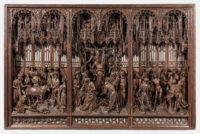 The Saint George Altarpiece, a masterpiece of wood carving by Flemish Renaissance sculptor Jan Borman, has gone back on display at the Art & History Museum in Brussels after three years of meticulous restoration that returned it to its original gory glory.
The Saint George Altarpiece, a masterpiece of wood carving by Flemish Renaissance sculptor Jan Borman, has gone back on display at the Art & History Museum in Brussels after three years of meticulous restoration that returned it to its original gory glory.
The retable is monumental in size at 5 meters (16’5″) wide and 1.6 meters (5’3″) high and features more than 80 figures carved in exquisite detail in a high Gothic architectural setting. It depicts seven scenes from the 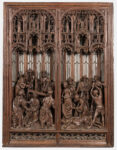 martyrdom of Saint George, who according to a 6th century hagiography suffered more than 20 different forms of torture over seven years in an unusually dedicated but nonetheless fruitless attempt to get him to renounce his beliefs. The scenes are dynamically composed, capturing the figures mid-motion: George quartered on a wheeled mechanism, George decapitated, George sawed through the head, George cooked on a brazier, George tied to a pole and flagellated, George roasted in a brazen bull, George hanging upside down over a fire.
martyrdom of Saint George, who according to a 6th century hagiography suffered more than 20 different forms of torture over seven years in an unusually dedicated but nonetheless fruitless attempt to get him to renounce his beliefs. The scenes are dynamically composed, capturing the figures mid-motion: George quartered on a wheeled mechanism, George decapitated, George sawed through the head, George cooked on a brazier, George tied to a pole and flagellated, George roasted in a brazen bull, George hanging upside down over a fire.
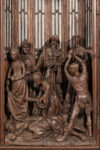 The altarpiece was commissioned for the Chapel of Our Lady Outside the Walls at Leuven, founded in 1364 by the Guild of Crossbowmen. In those pre-Reformation times, members of the volunteer municipal militia (think Rembrandt’s Night Watch) had religious requirements as part of the job and often endowed chapels and churches which they then used for solemn ceremonies and to intercede with their patron saints. Saint George was one of them. In Leuven, members swore their oath of allegiance to the guild in the chapel, and they were required to bequeath their coats of arms and crossbows to the chapel after their death.
The altarpiece was commissioned for the Chapel of Our Lady Outside the Walls at Leuven, founded in 1364 by the Guild of Crossbowmen. In those pre-Reformation times, members of the volunteer municipal militia (think Rembrandt’s Night Watch) had religious requirements as part of the job and often endowed chapels and churches which they then used for solemn ceremonies and to intercede with their patron saints. Saint George was one of them. In Leuven, members swore their oath of allegiance to the guild in the chapel, and they were required to bequeath their coats of arms and crossbows to the chapel after their death.
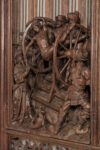 Politics appears to have played an important part in the commissioning of this altarpiece as well. Saint George also happened to the patron saint of Archduke Maximilian of Austria who had recently defeated Flemish rebels and retained control of the Netherlands. The Guild had sided against Maximilian, nearly emptying their coffers over the course of the rebellion. They spent the last of their ready cash commissioning the altarpiece from Jan Borman who was a favored court artist of Maximilian’s. It seems to have done the trick as Maximilian chose not to inflict punitive measures on the Guild.
Politics appears to have played an important part in the commissioning of this altarpiece as well. Saint George also happened to the patron saint of Archduke Maximilian of Austria who had recently defeated Flemish rebels and retained control of the Netherlands. The Guild had sided against Maximilian, nearly emptying their coffers over the course of the rebellion. They spent the last of their ready cash commissioning the altarpiece from Jan Borman who was a favored court artist of Maximilian’s. It seems to have done the trick as Maximilian chose not to inflict punitive measures on the Guild.
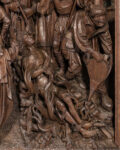 The Crossbowmen recovered from the setback. They poured money into their chapel, commissioning exceptionally fine artworks like The Descent from the Cross by Rogier Van der Weyden, now in the Prado Museum http://www.museodelprado.es/en/visit-the-museum/15-masterpieces/work-card/obra/descent-from-the-cross/ because Philip II of Spain demanded it for his palace and bullied the city council of Leuven to sell it to him over the vociferous protests of the Guild of Crossbowmen.
The Crossbowmen recovered from the setback. They poured money into their chapel, commissioning exceptionally fine artworks like The Descent from the Cross by Rogier Van der Weyden, now in the Prado Museum http://www.museodelprado.es/en/visit-the-museum/15-masterpieces/work-card/obra/descent-from-the-cross/ because Philip II of Spain demanded it for his palace and bullied the city council of Leuven to sell it to him over the vociferous protests of the Guild of Crossbowmen.
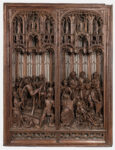 Alas, that would not be the last the chapel was looted. In 1798 the government of the Batavian Republic, a client state of revolutionary France, abolished all the guilds and Our Lady Outside the Walls was sold. All of the art, all of the silver decorations, the gold leaf, even the copper from the chandeliers was sold off, leaving only an empty husk of a building. It was demolished later that year and private homes built at the site.
Alas, that would not be the last the chapel was looted. In 1798 the government of the Batavian Republic, a client state of revolutionary France, abolished all the guilds and Our Lady Outside the Walls was sold. All of the art, all of the silver decorations, the gold leaf, even the copper from the chandeliers was sold off, leaving only an empty husk of a building. It was demolished later that year and private homes built at the site.
As the only extant signed piece by Borman and the only work of his whose original commission document has survived, the retable would be a unique treasure even if it weren’t widely acknowledged to be his greatest masterpiece. Experts from the museum and the Royal Institute for Cultural Heritage (KIK-IRPA) took the opportunity to study the work in detail, 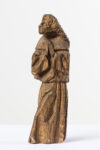 dismantling the 48 separate wooden elements. They found hidden surprises. Small parts like fingers and an earring that had fallen off and been trapped under the foreground scenes and one rough hand-carved figure of a praying man. Radiocarbon analysis found that the prayerful man dates to the late 15th century, so researchers believe it may have been a votive that Borman secretly hid in the altarpiece as a prayer for grave.
dismantling the 48 separate wooden elements. They found hidden surprises. Small parts like fingers and an earring that had fallen off and been trapped under the foreground scenes and one rough hand-carved figure of a praying man. Radiocarbon analysis found that the prayerful man dates to the late 15th century, so researchers believe it may have been a votive that Borman secretly hid in the altarpiece as a prayer for grave.
Another surprise was found when the central scene was dismantled: a parchment left behind by one Sohest declaring he had done some restoration work on it in 1835. As the surreptitious addition of a parchment  into the altarpiece might suggest, Sohest didn’t prioritize non-invasive conservation in as close to original condition as possible. The restoration team discovered that the wooden pegs and nails keeping the figures attached did not match the holes. Sohest had dismantled the scenes and put them back together in the wrong order. That inexplicable mistake has now been corrected and the scenes are now in the original order.
into the altarpiece might suggest, Sohest didn’t prioritize non-invasive conservation in as close to original condition as possible. The restoration team discovered that the wooden pegs and nails keeping the figures attached did not match the holes. Sohest had dismantled the scenes and put them back together in the wrong order. That inexplicable mistake has now been corrected and the scenes are now in the original order.
Emmanuelle Mercier, wood sculpture expert (KIK-IRPA): “Careful observation and laboratory analyses revealed that, contrary to tradition, the altarpiece had never been covered with polychromy. That also explains the remarkably fine carving of the wood, which would be lost even under the thinnest layer of paint. Jan II Borman also amazed us with his ability to carve complex scenes, with different figures, from a single block of wood. Tree ring analysis showed that he worked with the hard type of oak found in our regions. All these elements indicate exceptional talent.”
The restorers removed dust and dirt from the countless fine reliefs, glued the pieces of wood that over the years had fallen into the case, and consolidated areas weakened by woodworm. The layers of non-original nineteenth century patina in various shades and the black layer of wax that marred several faces were also thinned down and harmonised. Thus, the plasticity of the contours comes into its own again, and all the fine details are visible.
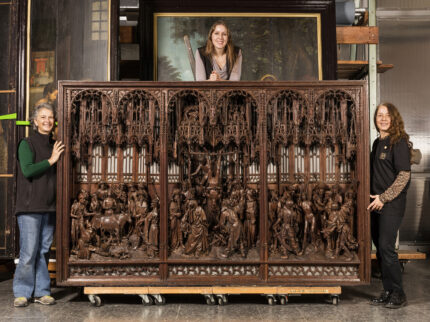
In the decapitation panel, it appears there is a second martyr, a woman, who is about to be executed, as her braids have been wrapped on top of her head, and she seems to be praying or petitioning St. George. The expressions on the faces are true to human experience, self-righteous, indifference, smug, or downright jubilant congratulating themselves on a job well-done, but the saint’s expression does not change at all in any of the panels: resting in the Spirit as he doubtless intercedes for their souls.
I saw that with the female as well! This is truly one of the best works of art I have seen. The skill it took amazes me.
Great Job! –That rather unfinished, or botched?, “prayerful man” from “the late 15th century” is indeed contemporary to the piece itself from 1493AD, and therefore, the wood should be the same.
In between Brussels and Leuven, or more south to it, there is –with plenty of hard trees– the ‘Foret de Soignes’ or ‘Zonienwoud’.
In Nicomedia (Νικομήδεια, i.e. what is now Izmit in Turkey) the kick-off for the long lasting ‘Diocletianic Persecution’ of Christians took place in 303AD, when Diocletian issued his “First Edict”.
Apparently, there were a couple of executions taking place in that town. “Περὶ τῶν κατὰ Νικομήδειαν” (Eusebios, Church History, 8.5.1) reports:
———–
“At the moment when the decree against the churches was announced in Nicomedia – it was posted in a public and busy place – a man, by no means unknown, but distinguished by high secular dignities, in his zeal for God and full of fiery faith, took it down and tore it to pieces, because he considered it unholy and very godless. In the same city there were at the time two emperors [Diocletian and Galerius], the oldest of them and the one who took the fourth rank in the reign after him. The aforementioned man was the first to stand out in such a way among the contemporaries of that time. The punishment he endured for such a bold action in accordance with the law he bore cheerfully and calmly until his last breath.”
cf.: en.wikipedia.org/wiki/Diocletianic_Persecution
———–
:hattip:
PS: The “Art and History Museum” in Brussels seems to be the one formerly known as “Cinquantenaire Museum”. I was there, but unfortunately I do not remember having seen this G(e)orgeous Altarpiece. Instead, I saw plenty of tapestry and one mosaic.